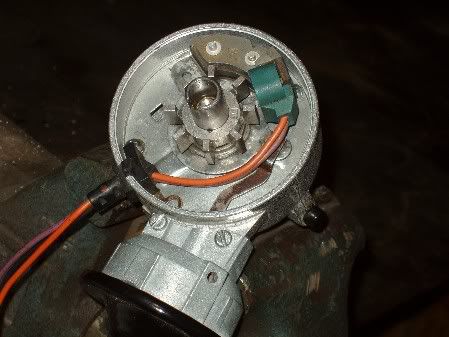The Ford electronic trigger unit for the Durspark II is really hard to beat - and it is readily retrofited into the Y-block distributors produced after 1957. There are numerous reference posts on this forum - if you need help - send me a PM. The trigger is superior because it makes its own power -the reluctor / armature spins in a permanent magnet field and makes an AC pulse at 1/2 engine rpm x 8 - the only thing that can stop it is a broken lead wire. A diode in the controller chops it into a binary "on" and "off" - and a timing chip does the rest (operates a power transistor to ground the coil).Once you have a trigger that works - all sorts of controllers will operate the coil - this is an induction style system so the trigger and controller are just basically replacing a set of points. The power transistor mentioned earlier - governs just how many amps the controller can handle.

Three relatively cheap controllers are available - Ford, GM and Chrysler all made one. Charlie's outfit has a MOPAR style controller with a Ford trigger, I've run mine with Duraspark II controllers and a GM HEI "four pin" - I think the Ford set-up is superior at idle - but the GM arrangement can make big sparks "upstairs". The Ford units are designed with two things I like - (1) at start-up it detects the starter solenoid operation and retards spark 6° and (2) Dwell is fixed at 26° which gives plenty of spark at low rev's. I believe total resistance - for the coil primary and ballast resistance needs to be 1.2 OHMs or more - or the transistor in the Ford controller will die.
The GM four pin runs the dwell down at low rpm (15°) to keep things cool and then keeps jacking it up as the rev's go up (35°). Because the GM system can (and will) change dwell timing to limit amperage - it can run a coil with no ballast resistor.

The best thing about adapting the "big three" parts - is that they are available cheap and install quickly (on any Sunday afternoon). I could change my controller for a spare in about 15 minutes and that would include opening the trunk. No burnt fingers or slaving over the engine either. The aftermarket versions - like the MSD - Pertronix are neither cheap to buy or convenient to replace.
It was worth figuring out how to build this system and maintain it - all of the regular distributor tuning tricks still work - centrifugal advance changes, vacuum pot adjustments, etc.